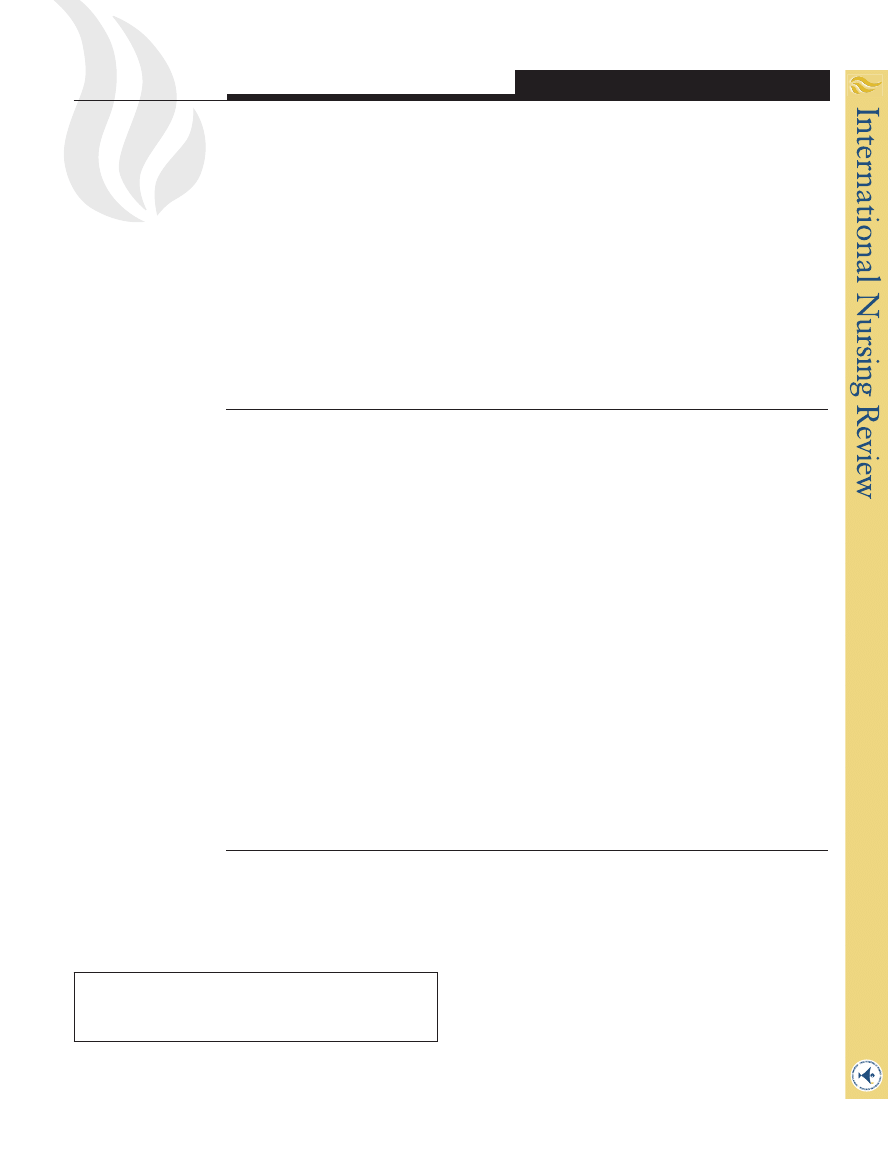
Job satisfaction of nurses in a Saudi
Arabian university teaching hospital:
a cross-sectional study
inr_978
424..430
R. AL-Dossary
1,2
BSN
,
RN
,
MSC
,
P
hD Candidate
, J. Vail
3
RN
,
P
hD
&
F. Macfarlane
4
BSC
,
MBA
,
P
hD
,
FHEA
,
CFCIPD
1 Lecturer, Nursing College, Dammam University, Dammam, Saudi Arabia, 2 PhD Student, 3 Associate Professor, Assistant
Dean of Doctoral Studies, College of Health and Human Services, George Mason University, Fairfax, VA, USA, 4 Senior
Lecturer and Programme Leader NHS, Clinician and Manager for the MSc Health Care Management, School of Management,
Surrey University, Surrey, Guildford, UK
AL-DOSSARY R., VAIL J. & MACFARLANE F. (2012) Job satisfaction of nurses in a Saudi Arabian university
teaching hospital: a cross-sectional study. International Nursing Review 59, 424–430
Background: Saudi Arabia is developing very fast in all disciplines, especially in nursing and health. Only
about five studies between 1990 and 2010 have been undertaken in Saudi Arabia concerning factors
influencing job satisfaction of nurses, although a body of knowledge exists globally.
Aim: The purpose of this research was to measure nurses’ job satisfaction in Saudi Arabia in a university
teaching hospital and to determine the influencing factors.
Methods: A quantitative, cross sectional method, self-administered questionnaire was used for this study. A
systematic sample of N
= 189 nurses was used to collect data. The SPSS version 16.0. was used to analyze the
data. An independent t-test and one-way analysis of variance were used to test hypotheses concerning different
groups, and correlation tests (the Pearson’s and Spearman’s rank tests) were used to examine relationships
between variables.
Results: Overall, nurses were neither satisfied nor dissatisfied with their jobs. However, nurses indicated
satisfaction with supervision, co-workers and nature of work. The sources of dissatisfaction were with
subscales such as pay, fringe benefits, contingent rewards and operating conditions.
Conclusion: These findings indicate that there is a need to increase nurses’ salaries and bonuses for extra
duties. More training programmes and further education also should be encouraged for all nurses. Therefore,
it is imperative that nursing managers and policy makers in Saudi Arabia consider these findings to improve
nurses’ job satisfaction.
Keywords: Job Satisfaction, Nurses, Saudi Arabia, University Teaching Hospital
Introduction
Job satisfaction is a crucial issue to any healthcare organization as it
is an indicator of the physical and psychological states of its employ-
ees. Therefore, it is important for administrators to understand the
basis of job satisfaction because of the serious impact of dissatis-
faction in the workplace. In nursing, job satisfaction as a topic has
been studied, discussed and recognized as a key indicator of nurses’
performance, cost savings and quality of patient care (Seago et al.
2011). This reflects that a body of knowledge exists globally regard-
ing the factors influencing nurses’ satisfaction; however, between
1990 and 2010, only about five studies have been undertaken in
Saudi Arabia related to this issue (Al-Aameri 2000; Al-Ahmadi
2002, 2009; Badawy & Essawy 1992; El-Gilany & Al-Wehady 2001).
Correspondence address: Mrs Reem AL-Dossary, Nursing College, Dammam
University, Dammam, Saudi Arabia, 4400 University Drive, Fairfax, VA, 22030,
USA; Tel: 1571-337-8557; Fax: 703-993-1942; E-mail: rm_aldossary@
hotmail.com, raldossa@gmu.edu.
bs_bs_banner
Nurses’ Work-Life Experiences
© 2012 The Authors. International Nursing Review © 2012 International Council of Nurses
424

Saudi Arabia is the largest country in the Middle East, covering
an area of 2.25 million square kilometres. Saudi Arabia has the
largest reserves of petroleum in the world and is the largest
exporter (Mufti 2000; The Central Intelligence Agency World
Fact Book 2011). Saudi Arabia is developing very fast in all dis-
ciplines, especially in nursing and health (Aldossary et al. 2008).
However, the demand for labour in the health sector cannot be
met by Saudi nationals alone because of the relatively small
number of Saudi graduates from nursing schools (Abu-Zinadah
2004). Consequently, most of the healthcare providers are expa-
triate from different countries. For example, nurses come from
over 40 different countries, including the United Kingdom,
Ireland and the USA (Aboul-Enein 2002; Aldossary et al. 2008).
Therefore, identifying factors influencing job satisfaction of
nurses in a university hospital in Saudi Arabia was believed to be
needed.
Background
There are numerous factors that have an impact on nurses’ sat-
isfaction. One is that the role of the nurse has changed dramati-
cally and become more complex over the past decade (Mrayyan
2005). The role change, along with other issues such as the eco-
nomic downturn that currently impacts on most hospitals, may
have an impact on job satisfaction among nurses. Studies have
also shown that job satisfaction may be affected by demographic
factors such as age; shift work and pay; and professional factors
including years of experience, position and education (Al-
Ahmadi 2009; Hu & Liu 2004; Larrabee et al. 2003; Yaktin et al.
2003).
Some studies have shown that age and years of experience are
factors that affect nurses’ job satisfaction. For example, Yaktin
et al. (2003) showed that in Lebanon, nurses older than 30 were
more satisfied than younger nurses. Al-Aameri (2000) con-
ducted a study in public hospitals in Riyadh city, Saudi Arabia,
and found that the nurses’ age is significantly correlated with
his/her job satisfaction and commitment. Al-Ahmadi (2002)
also found that job satisfaction is positively correlated with years
of experience. However, the nursing literature contains conflict-
ing evidence regarding the relationship among age, years of
experience and job satisfaction. Age was not related to job sat-
isfaction in a sample of 3472 nurses employed in a variety of
patient care settings (Ma et al. 2003). Ma’s study also found that
nurses who had over 2 years work experience had lower levels of
job satisfaction in comparison with those who had less than
2-year work experience. A Chinese study also argued that there is
no difference between different age groups and job satisfaction
(Hu & Liu 2004). This study, however, found a significant dif-
ference between nurses who had worked for less than 10 years
and those who had worked for more than 10 years (P
< 0.01).
Larrabee et al. (2003) found that age was not correlated with job
satisfaction.
Shift work is another factor that affects nurses’ job satisfaction.
Havlovic et al. (2002) looked at the impact differing work shifts
had on full-time and part-time nurses. The study showed that
shift work and night work may affect nurses’ health condition
and their sleeping patterns. Consequently, these nurses reported
lower job satisfaction. According to the Federation of Nurses and
Health Professionals (2001), the increased use of overtime is
frequently cited as a key reason for job dissatisfaction among
nurses. This is where there is a tendency for the working hours to
be related to shift work rather than the length of the working
week. Al-Ahmadi (2009) in a study conducted in Saudi Arabia
tried to identify factors influencing self-reported performance
of hospital nurses, and to determine whether differences in
employee demographics, job satisfaction and organizational
commitment influenced performance The study found that job
performance is positively correlated with organizational com-
mitment, job satisfaction and personal and professional vari-
ables. Both job satisfaction and organizational commitment are
strong predictors of nurses’ performance.
Pay and benefits are mentioned in other studies as important
components of job satisfaction (Ravari et al. 2011; Sparks et al.
2005). Curtis (2007) in the Republic of Ireland also showed that
pay is crucial to nurses’ satisfaction. Pay was identified as the
second most important component, yet it made the least contri-
bution to nurses’ current level of satisfaction. The study also
indicated that nurses’ professional status and the level of inter-
action autonomy (being responsible for day-to-day decisions)
were also factors that contributed to nurses’ job satisfaction.
Al-Ahmadi (2002) in a study on 500 nurses in nine Ministry of
Health hospitals in Riyadh, Saudi Arabia, found that the most
important determinants of job satisfaction were work conditions
and pay.
In addition, a study in Jordan that measured nurses’ job sat-
isfaction found that there was a considerable variation between
the findings of head nurses and staff nurses. The study suggested
that senior nurses may have had a more optimistic view of their
hospital than the younger, staff nurses (Mrayyan 2006). Addi-
tionally, a study has shown that there is a strong relationship
between the nurses’ position and his/her job satisfaction (Hu &
Liu 2004). In this study, participants who held the professional
title of chief nurse or higher were more satisfied with their work
than those nurses who held the professional title of senior nurse
or lower.
Hu & Liu (2004) also demonstrated that there is a relationship
between level of education and job satisfaction. Participants who
had an associate degree in nursing felt a greater sense of accom-
Job satisfaction of nurses in a Saudi Arabian hospital
425
© 2012 The Authors. International Nursing Review © 2012 International Council of Nurses

plishment and higher job satisfaction compared with those who
had a diploma in nursing. Al-Ahmadi (2002) also found differ-
ences in satisfaction according to educational level. In Kuwait,
Al-Enezi et al. (2009) studied job satisfaction of nurses with mul-
ticultural backgrounds. Their aim was to identify factors related
to the job satisfaction of nurses and the effect of selected back-
ground characteristics on nurses’ job satisfaction. They found an
inverse relationship between job satisfaction and higher levels of
education. In another study in Kuwait, Shah et al. (2004) stated
that nurses’ education level is a significant predictor of job
satisfaction.
Purpose and objectives
The purpose of this study was to measure nurses’ job satisfaction
in a university teaching hospital in Saudi Arabia.
The objectives were to (1) examine to what extent nurses in
this hospital were satisfied with their jobs; (2) determine the
factors, which increase or decrease the level of job satisfaction;
(3) explore the relationship among the factors that affect job
satisfaction; and (4) provide suggestions for policy makers and
managers to improve delivery of care by increasing job satisfac-
tion among the subject nurses.
Methods
Design and sample
This study used a cross-sectional, quantitative research design. It
took place in a university teaching hospital in the Eastern Prov-
ince of Saudi Arabia. The questionnaire was piloted in January
2008 using a small group of 25 Saudi and non-Saudi nurse. This
pilot was to determine the level of understanding, any language
or phrase difficulties, comprehension and length of time to com-
plete the survey. The researcher talked to all the respondents after
they answered the questionnaire, and they verified that the lan-
guage of the survey was readable and easy to comprehend, as all
the respondents did read and write in English. Thus, the
researcher proceeded with the English format for both Saudi
nurses and non-Saudi nurses. The survey instrument was not
examined for use in a different culture or environment other
than the original ones, as most of the subjects (n
= 167) were
from Western cultures, and the Saudi nurses (n
= 50) anecdotally
have a Westernized exposure and were familiar with Western
cultures. It took the respondents approximately 20 min to com-
plete the questionnaire.
A systematic sampling method was used. The researcher had
targeted all the nurses (N
= 500) in a teaching hospital in the
Eastern Province of Saudi Arabia. The administration of the
hospital provided the researcher with a spreadsheet including all
names of the nurses, gender, age and educational status. A sample
decision model by Krejcie & Morgan (1970) was used for deter-
mining the sample size, which was selected by taking the first and
then every fifth (5th) nurse. The population consisted of 500
nurses, and a systematic sample of 217 nurses was drawn from
this population.
Instruments
The job satisfaction survey (JSS; Spector 1997) was used in this
research. It examines nine subscales of job satisfaction as well as
overall satisfaction. The scale contains 36 items in a summated
rating scale format. Each subscale has four items. The response
format is a six-point Likert scale, 1–6 for each item ranging from
‘strongly agree’ to ‘strongly disagree’. However, some of the items
are scored in a positive and some in a negative direction. In
positively worded items, agreement means job satisfaction. On
the other hand, negatively worded items, agreement indicates
dissatisfaction. As a result, before items were combined, the nega-
tive items were reversed as directed by Spector (1985). The pro-
cedure of recoding the negative items was by renumbering the
negatively worded items responses from 6 to 1 rather than from
1 to 6. The response ‘disagree very much’ becomes a 6 rather than
a 1, and the response ‘agree very much’ becomes a 1 rather than
a 6. Similarly, the response ‘disagree moderately’ becomes a 5
rather than a 2, and the response ‘agree moderately’ becomes a 2
rather than a 5. In addition, the response ‘disagree slightly’
becomes a 4 rather than a 3, and the response ‘agree slightly’
becomes a 3 rather than a 4. After the items were reversed, the
numbered responses for the appropriate items were summed as
shown in Table S1. The total satisfaction score is the sum of the
36 items. The total score can range from 36 to 216.
The JSS has been evaluated for reliability by two types of
reliability estimates. First, internal consistency (Cronbach’s
alpha); which refers to how well items of a scale relate to one
another. Second, test–retest reliability shows the stability of the
scale overtime. The time between test and retest was 18 months.
Test–retest reliability ranged from 0.37 to 0.74 (Spector 1997).
According to van Saane et al. (2003), the JSS was one out of the
29 instruments that meet the quality criteria for reliability and
validity as a tool to be used in a hospital environment. The
Cronbach’s alpha in this study was 0.70; it indicates good reli-
ability, as the widely accepted minimum standard for internal
consistency is 0.70 (Nunnally 1978).
For JSS validity, evidence is provided by studies that compared
different scales with one another on the same employees such
as five of the JSS subscales (pay, promotion, supervision,
co-workers and nature of work) correlate well with correspond-
ing subscales of the job description index (Spector 1997), which
perhaps is the most carefully validated scale of job satisfaction.
426
R. AL-Dossary et al.
© 2012 The Authors. International Nursing Review © 2012 International Council of Nurses

These correlations ranged from 0.61 for co-workers to 0.80 for
supervision (Spector 1997).
Data collection and analysis
The data were collected over a 3-month period from March to
May, 2008, using a self-administered questionnaire. In this study,
the data analysis was done by the assistance of a software pro-
gramme, the SPSS version 16.0 (SPSS Inc., Chicago, IL, USA).
The researcher carried out four steps to analyze data: first, pre-
paring the data for analysis, and, second, by acquiring ‘a feel’ for
the data. This was done by measuring the central tendency and
dispersion. Descriptive statistics was used to analyse demo-
graphic data. Inferential statistics (i.e. Pearson’s correlation)
were used to test the correlation between general job satisfaction
and the nine subscales. Third, testing the goodness of data was
determined through the previously calculated reliability and
validity of the existing scale. Finally, the independent sample
t-test and one-way analysis of variance (ANOVA) were used to
test the hypotheses generated in this study. The confidence inter-
vals (CI) were adjusted at 95%.
Approval for this research was received from the Human
Studies Review Board of the University Teaching Hospital where
the research was conducted. All participants were informed of
the purpose of the study and were given the right to refuse to
participate. The questionnaire had a cover page attached that
introduced the importance of this study, and stated how it could
help in exposing the various factors responsible for affecting job
satisfaction among the nurses in a teaching hospital. In this
research, no personal identification was asked, thus ensuring
anonymity. Confidentiality was maintained, and all data were
treated as aggregate data.
Results
A total of 200 surveys were returned from the original 217
packets that were distributed, the return rate was 87.5%. Of the
200 respondents, 197 provided usable surveys and demographic
information. All cases with missing data were excluded; there-
fore, the final sample for data analysis consisted of 189 staff
nurses who worked in the teaching hospital. Of the 189 subjects,
20% were under 30 years old, 42% were between 31 and 45 years
old and 38% were over 46 years old. The sample was composed
of 88.36% females and 11.64% males. In addition, 88.4% of the
nurses working in the teaching hospital were non-Saudi, only
11.6% were Saudi. According to the Ministry of Health in 2008,
the Saudi nursing workforce consists of 29.1% of the actual
nursing manpower available in Saudi Arabia, and 70.9% are
non-Saudi, which is not exactly comparable with the population
surveyed in this study (Almalki et al. 2011).
Overall, most nurses in this study were neither satisfied nor
dissatisfied with their jobs. General job satisfaction demon-
strated a significantly, strong, positive correlation to subscales
such as pay, supervision, contingent rewards, co-workers, nature
of work and communication. However, job satisfaction was only
moderately correlated with factors such as promotion, operating
conditions and fringe benefits. A large proportion of the sample
(56.9%) preferred morning shifts (from 7:00 AM to 3:00 PM)
as good working hours. This preference was most prominent
among all Saudi female nurses and non-Saudi male nurses
(68.2% compared with 55.2%). Among the 29.4% who preferred
evening shifts (from 3:00 PM to 11:00 PM), most of them
(92.7%) were non-Saudi female nurses, and among the 9.1%
who preferred the night shift (from 11:00 PM to 7 AM), all of
them were non-Saudi nurses. Approximately 5% of those studied
had no preference for individual shifts. They felt that all shifts are
the same.
The relationship of personal-related factors to nurses’ job sat-
isfaction was examined. A one-way ANOVA between groups
was carried out to investigate the impact of age on nurses’ level
of satisfaction. The subjects were divided into three groups
according to their age (group one: under 30 years old; group
two: age 31–45 years; and group three: over 45 years old). The
Levene’s test for homogeneity of variance of 1.307 (P
= 0.273)
indicated that the assumption of homogeneity of variance was
not violated. A non-significant relationship was found between
age and job satisfaction (P
= 0.223). An independent-sample
t-test was preformed to compare general job satisfaction scores
for males and females. There was no significant difference in
scores for males [M
= 125.38 and standard deviation (SD) =
16.076] and females (M
= 122.96, SD = 19.225); t(186) = .564,
P
= .57 (two-tailed). The magnitude of the difference in the
means (mean difference
= 2.417, 95% CI: -6.041 to 10.875) was
very small (eta squared
= 0.002). Only 0.2% of the variance
in general job satisfaction is explained by gender. Although
non-Saudi male nurses exhibited higher mean scores for most
of the nine subscales of general job satisfaction compared with
female nurses, except for pay, promotion, co-workers and
nature of work, the results of t-tests show no overall significant
relationship between gender and the nine subscales of job
satisfaction.
The effect of practice related to factors on nurses’ job satisfac-
tion was examined. The relationship between general job satis-
faction and numbers of patients per nurse, per shift was
investigated using Spearman’s rank correlation test. The Spear-
man’s correlation test was not statistically significant (n
= 187,
Spearman’s correlation rho
= 0.015, P = 0.836). Each patient care
unit was staffed with approximately 15–20 nurses. The number
of patients assigned to each nurse varied from unit to unit
Job satisfaction of nurses in a Saudi Arabian hospital
427
© 2012 The Authors. International Nursing Review © 2012 International Council of Nurses

according to the care each patient needed. Forty-three percent of
the nurses cared for less than five patients per shift (these were
usually in intensive care units), while 42% of the nurses were
responsible for more than eight patients (in general care units).
The data demonstrated that increased number of patients
assigned per shift was not a source of job dissatisfaction. The
majority of the nurses (91%) worked full-time. Eighty-six
percent of the non-Saudi nurses had an income less than 5000
Saudi Riyals per month (approximately US$1333.33).
Examining the effect of professional-related factors on nurses’
job satisfaction, there was a statistically significant correlation
(n
= 182, rho = +0.137, P = 0.006) between the number of years
of nursing experience and the general job satisfaction. Interest-
ingly, in the regression model for general job satisfaction, in
which the non-normal distribution of the number of years of
experience was not taken into account, the number of years of
nursing experience was found to be statistically significant
(P
= 0.029) with a parameter of 0.357, indicating that for each
additional year of experience, a non-Saudi nurse’s general job
satisfaction rises by 0.357. Furthermore, in this study, the rela-
tionship between general job satisfaction and position level, for
example, staff nurse, charge nurse, nurse supervisor and nurse
director was not statistically significant (n
= 188, rho = -0.064,
P
= 0.380). Forty percent had a diploma, 32% were non-Saudi,
59% had a BSc, 15% were Saudi and 1% held a master’s degree.
There was no significant difference in general satisfaction scores
(P
= 0.249) for the education groups.
Discussion
It can be concluded that most nurses were satisfied with the
leadership style of their direct supervisors. In addition, most
nurses were satisfied with their relationship with their colleagues
and the work they did. However, dissatisfaction was associated
with subscales such as pay, fringe benefits, contingent rewards
and operating conditions. Nevertheless, nurses were neither dis-
satisfied nor satisfied with themes such as promotion and com-
munication. Most of the participants were females, and a non-
significant relationship was found between gender and job
satisfaction (P
= 0.57), two-tailed test statistic. These results were
supported from the literature (Siu 2002). Non-Saudi male nurses
exhibited higher means on most of the nine subscales of general
job satisfaction compared with female nurses, except for pay,
promotion, co-workers and nature of work. The results of t-tests
showed no significant relationship between gender and the nine
subscales of job satisfaction.
The relationship between general job satisfaction and number
of patients assigned per shift was not statistically significant.
Although some studies agree that increased number of patients
assigned per shift is a common source of job dissatisfaction
(Mrayyan 2005; Yaktin et al. 2003), the results of this study do not
agree with those findings. In addition, a large proportion of the
sample (56.9%) preferred morning shifts (7:00 AM to 3:00 PM) as
good working hours in a teaching hospital; this preference was
most prominent among all Saudi female nurses and non-Saudi
male nurses (68.2% compared with 55.2% for females). This
supports the findings of other studies that indicate that nurses’ job
satisfaction was influenced positively by the convenient job sched-
ule that afforded the opportunity to meet the nurses’ personal and
family needs (Brooks & Swailes 2002; Hoffman & Scott 2003).
The relationship between general job satisfaction and monthly
income was not statistically significant. The results of this study
agrees with another study that salaries constitute only a small
facet of job satisfaction compared with other factors, which may
be perceived as being much more important (Burnard et al.
1999). This study also shows a significant correlation between the
number of years of nursing experience and general job satisfac-
tion. This would also support findings of other studies (Hu & Liu
2004; Yaktin et al. 2003).
In this study, the relationship between general job satisfaction
and position level was not statistically significant (staff nurse vs.
charge nurse vs. nurse supervisor vs. nurse director). The findings
of this study contradict results from other research that there is a
relationship between general job satisfaction and position level
(Curtis 2007; Ma et al. 2003; Mrayyan 2006). These results may
have occurred because 69.3% of the sample were staff nurses and,
there were not enough nurses of higher position to tell if such a
relationship exists. Another reason may be that the majority of the
sample (88%) was non-Saudi, and most of them (87%) were in
the positions of staff nurse. There was no significant difference in
general satisfaction scores (P
= 0.249) for the education groups.
Limitations
Several issues limit the generalizability of the results of this study;
for example, the narrow context of the study, which is a single
university hospital, and the modest sample size. In addition, in
this sample, there was a disparity in the number of Saudi nurses
(n
= 50) and non-Saudi nurses (n = 167). However, this reflects
the reality of the Saudi Arabian nursing workforce, which con-
sists of 70.9% non-Saudi nurses and 29.1% Saudi nurses
(Almalki et al. 2011). Also, the insufficient amount of informa-
tion and resources regarding job satisfaction among nurses in
teaching hospitals in Saudi Arabia was a constraining factor. This
deficiency can be attributed to the fact that there has been little
research in Saudi Hospitals.
Recommendations
The following recommendations are made to improve nurses’
satisfaction and, thus, the quality of care provided in Saudi teach-
428
R. AL-Dossary et al.
© 2012 The Authors. International Nursing Review © 2012 International Council of Nurses

ing hospitals. (1) Most nurses in this research were dissatisfied
with pay, fringe benefits, operating conditions and contingent
rewards received. Therefore, nurses’ job satisfaction may
improve if incentives are provided, such as increased pay and
bonuses for extra duties. (2) Nurses who perform well should be
encouraged by giving them early promotions.
Suggestions for future research
Further research into this subject area is needed to validate the
factors influencing nurses’ job satisfaction in Saudi Teaching
Hospitals. It would be ideal if this research was replicated con-
centrating on a larger sample of nurses from the other teaching
hospitals, both governmental and private, in Saudi Arabia. Addi-
tionally, it would be useful to study both Saudi and non-Saudi
nurses and to compare the results. Moreover, it would be useful
to use mixed methods research (quantitative and qualitative) to
study job satisfaction in this population to gain a better under-
standing of the issues and to increase the knowledge about job
satisfaction in both Saudi and non-Saudi nurses.
The study was cross-sectional. Future research should include
a longitudinal study where the respondents could be followed for
a period of time instead of on a ‘one-shot’ basis. This will help to
discover any changes in nurses’ satisfaction levels and factors
associated with changes. In addition, the Ministry of Health
should fund an ongoing survey concerning job satisfaction by
identifying a large and diverse cohort of nurses and surveying
them annually to substantiate the findings in this study.
Conclusion
This study has provided information about the factors influenc-
ing nurses’ job satisfaction. Job satisfaction factors may change
over time; therefore, regular research is needed to discover any
changes. These findings should be born in mind for healthcare
managers for future decision making regarding nurses’ job sat-
isfaction. Nurses’ satisfaction with their jobs is an important key
to better work performance and staff retention.
The future challenge will be to encourage nurses and manag-
ers to all work together for a better workforce, which will ulti-
mately improve patient care of high quality. Any organizational
change within university hospitals should take into consider-
ation nurses’ job satisfaction.
Author contributions
All of the authors have contributed significantly in the develop-
ment of this work. Mrs. AL-Dossary contributed to the design,
collected and synthesized the data used in this paper, and wrote
the main text. Dr. Vail and Dr. Macfarlane contributed to the
design, editing and revisions of the manuscript, as well as pro-
vided supervision for the first author. All authors read and
approved the final manuscript.
References
Aboul-Enein, F.H. (2002) Personal contemporary observations of nursing
care in Saudi Arabia. International Journal of Nursing Practice, 8, 228–
230.
Abu-Zinadah, S. (2004) The situation of Saudi nursing. Health Forum, 52,
42–43.
Al-Aameri, A.S. (2000) Job satisfaction and organisational commitment for
nurses. Saudi Medical Journal, 21 (6), 531–535.
Al-Ahmadi, H.A. (2002) Job satisfaction of nurses in Ministry of Health
Hospitals in Riyadh, Saudi Arabia. Saudi Medical Journal, 23 (6), 645–
650.
Al-Ahmadi, H.A. (2009) Factors affecting performance of hospital nurses
in Riyadh Region, Saudi Arabia. International Journal of Health Care
Quality Assurance, 22 (1), 40–54.
Aldossary, A., While, A. & Barriball, L. (2008) Health care and nursing in
Saudi Arabia. International Nursing Review, 55, 125–128.
Al-Enezi, N., Chowdhury, R., Shah, M. & Al-Otabi, M. (2009) Job satisfac-
tion of nurses with multicultural backgrounds: a questionnaire survey in
Kuwait. Applied Nursing Research, 22, 94–100.
Almalki, M., FitzGerald, G. & Clark, M. (2011) The nursing profession in
Saudi Arabia: an overview. International Nursing Review, 58, 304–311.
Badawy, Y.A. & Essawy, M.A. (1992) Influence of job characteristics on J
Sof pediatric nurses. Journal of the Egyptian Public Health Association,
67 (3–4), 403–417.
Brooks, I. & Swailes, S. (2002) Analysis of the relationship between nurse
influences over flexible working and commitment to nursing. Journal of
Advanced Nursing, 38 (2), 117–126.
Burnard, P., Morrison, P. & Phillips, C. (1999) Job satisfaction amongst
nurses in interim secure forensic unit in Wales. Australian and New
Zealand Journal of Mental Health Nursing, 8 (1), 9–18.
Curtis, E.A. (2007) Job satisfaction: a survey of nurses in the Republic of
Ireland. International Nursing Review, 54 (1), 92–99.
El-Gilany, A. & Al-Wehady, A. (2001) Job satisfaction of female Saudi
nurses. Eastern Mediterranean Health Journal, 7 (1/2), 31–37.
Federation of Nurses and Health Professionals (2001) Perspective Current
Direct Care Nurse and Former Direct Care Nurses. Federation of Nurses
and Health Professionals: Washington, DC USA.
Havlovic, S.J., Lau, D.C. & Pinfield, L.T. (2002) Repercussions of work
schedule congruence among full-time, part-time, and contingent nurses.
Health Care Management Review, 27 (4), 30–41.
Hoffman, A.J. & Scott, L.D. (2003) Role stress and career satisfaction
among registered nurses by work shift patterns. Journal of Nursing
Administration, 33 (6), 337–342.
Hu, J. & Liu, H. (2004) Job satisfaction among nurses in China. Home
Health Care Management and Practice, 17 (1), 9–13.
Krejcie, R.V. & Morgan, D.W. (1970) Determining sample size for research
activities. Educational and Psychological Measurement, 30, 607–610.
Larrabee, J.H., et al. (2003) Predicting registered nurse job satisfaction and
intent to leave. Journal of Nursing Administration, 33 (50), 271–283.
Job satisfaction of nurses in a Saudi Arabian hospital
429
© 2012 The Authors. International Nursing Review © 2012 International Council of Nurses

Ma, C., Samuels, M. & Alexander, J. (2003) Factors that influence
nurses’ job satisfaction. Journal of Nursing Administration, 33 (5),
293–299.
Mrayyan, M.T. (2005) Nurse job satisfaction and retention: comparing
public to private hospitals in Jordan. Journal of Nursing Management,
13 (1), 40–50.
Mrayyan, M.T. (2006) Jordanian nurses’ job satisfaction, patients’ satisfac-
tion and quality of nursing care. International Nursing Review, 53 (3),
224–230.
Mufti, M. (2000) Healthcare Development Strategies in the Kingdom of
Saudi Arabia. Plenum, New York.
Nunnally, J.C. (1978) Psychometric Theory. McGraw-Hill, New York.
Ravari, A., Bazargan, M., Vanaki, Z. & Mirzaei, T. (2011) Job satisfaction
among Iranian hospital-based practicing nurses: examining the influ-
ence of self-expectation, social interaction, and organisational situations.
Journal of Nursing Management. DOI: 10.1111/j.1365-2834.2010.01188.x.
Available at: http://onlinelibrary.wiley.
com.mutex.gmu.edu/doi/10.1111/j.1365-2834.2010.01188.x/full
(accessed 30 May 2011).
van Saane, N., Sluiter, J.K., Verbeek, J.H.A.M. & Frings-Dresen, M.H.W.
(2003) Reliability and validity of instruments measuring job satisfaction
– a systematic review. Occupational Medicine, 53 (3), 191–200.
Seago, J.A., et al. (2011) Hospital RN job satisfaction and nurse unions.
Journal of Nursing Administration, 41 (3), 109–114.
Shah, M., Al-Enezi, N., Chowdhury, R. & Otaibi, M. (2004) Determinant
of job satisfaction among nurses in Kuwait. Australian Journal of
Advanced Nursing, 21, 10–16.
Siu, O. (2002) Predictors of job satisfaction and absenteeism in two
samples of Hong Kong nurses. Journal of Advanced Nursing, 40 (2),
218–229.
Sparks, S.A., Corcoran, K.J., Nabors, L.A. & Hovanitz, C.A. (2005) Job sat-
isfaction and subjective well-being in a sample of nurses. Journal of
Applied Social Psychology, 35 (5), 922–938.
Spector, P.E. (1985) Measurement of human service staff satisfaction:
development of the job satisfaction survey. American Journal of Commu-
nity Psychology, 13, 693–713.
Spector, P.E. (1997) Job Satisfaction: Application, Assessment, Causes and
Consequences. Sage, New York.
The Central Intelligence Agency World Fact Book (2011) Middle East Saudi
Arabia. Available at: https://www.cia.gov/library/publications/the-world-
factbook/geos/sa.html (accessed 31 October 2011).
Yaktin, U., Azoury, N. & Doumit, M. (2003) Personal characteristics and
job satisfaction among nurses in Lebanon. Journal of Nursing Adminis-
tration, 33 (7/8), 384–390.
Supporting information
Additional Supporting Information may be found in the online
version of this article:
Table S1 Subscale contents from the Job Satisfaction Survey
Please note: Wiley-Blackwell are not responsible for the
content or functionality of any supporting materials supplied by
the authors. Any queries (other than missing material) should be
directed to the corresponding author for the article.
430
R. AL-Dossary et al.
© 2012 The Authors. International Nursing Review © 2012 International Council of Nurses
Wyszukiwarka
Podobne podstrony:
Fizyka 0 wyklad organizacyjny Informatyka Wrzesien 30 2012
pmp wykład podmioty 2011 2012
Cukrzyca ciężarnych 2012 spec anestetyczki
KOMPLEKSY POLAKOW wykl 29 03 2012
Biotechnologia zamkniete użycie (2012 13)
(7657) wykł1id 1173 ppt
Alergeny ukryte Sytuacja prawna w Polsce i na Świecie E Gawrońska Ukleja 2012
NIEDOKRWISTOŚCI SEM 2011 2012
ANALIZA RYNKU NIERUCHOMOŚCI KOMERCYJNYCH W KRAKOWIE W LATACH 2008 2012
Niewydolność krążenia 2012
13 04 2012 TEST KOŃCOWY GASTROLOGIAid 14559 ppt
Wykład VIII 03 04 2012
więcej podobnych podstron